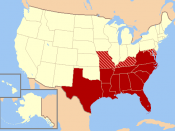Between 1815 and 1860, many advances in transportation and trade were made, and thus allowed more trade and interaction amid the American people. However, this interaction did not unify the people, but allowed more space for their differences to flourish. Soon, the Southerners had developed their own sense of identity, were extremely devoted to their own interests, and felt the need to separate from the North.
The road to the Civil War was lengthy and turbulent. It was partially based on the economic sectionalism, or local economic differences, of the America's two main regions, the North and the South. The North, a manufacturing region, found itself in conflict with the agricultural South. The two different regions required different political and economic policies. As the United States became more established and was able to focus its attention on economics, the two regions grew increasingly distant and hostile. Eventually, a division was created between the two regions.
This division was the foundation for the Civil War.
The first conflict that brought trouble between the two regions was the Missouri Compromise of 1820. This compromise allowed the admission of Missouri into the Union as a slave state and prohibited slavery above the 36'30 line. The Compromise also foreshadowed more sectional problems.
American business before the War of 1812 was centered around activities such as shipping and trade. But the war had cut off the supply of many manufactured goods from Europe and encouraged the growth of industry in America. So after independence, American industry, including transportation, was greatly improved.
The immense growth of both domestic and foreign commerce after 1840 created a need for transportation facilities. Steamboats and railroads developed to fill the need.
Steamboats had become popular from the time they had been introduced, in 1790. By 1830, there were more...


